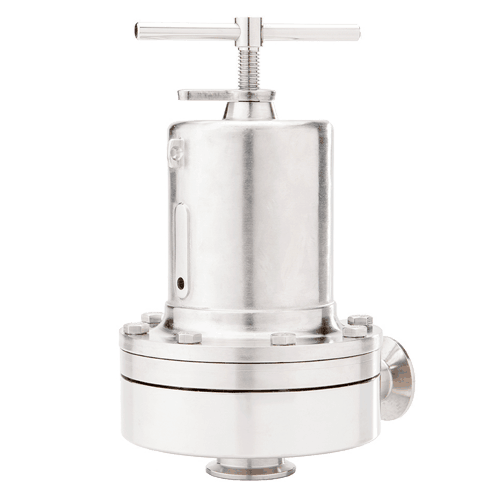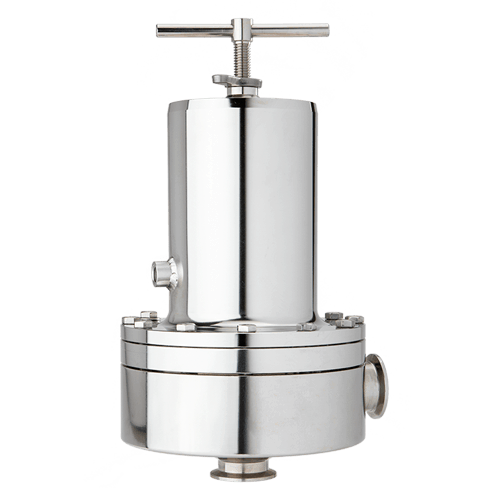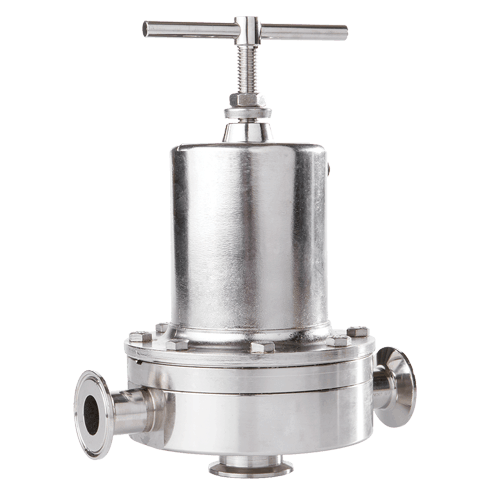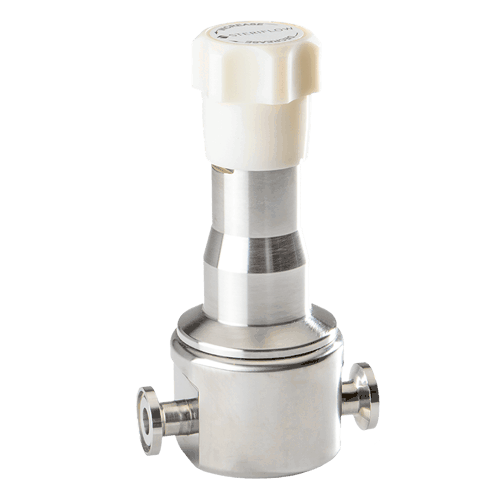Sanitary Back Pressure Regulators
Request a quote on our pharma process and clean utility back pressure regulating valves, 1/2" - 3" (DN15 - DN80) with tri-clamp or weld ends, low to high flow, manual or air augmented, all with the Jorlon™ lifetime diaphragm warranty.
What is a sanitary back pressure regulator?
A sanitary back pressure regulator is a back pressure regulator (BPRV) that is suitable for pharma or biopharma applications. Meaning, that a sanitary back pressure regulator has the right materials, the correct surface finish, the right end connections, and the right certifications (FDA and USP Class VI) for sanitary applications.
Types Of Sanitary Back Pressure Regulators We Carry
Mark 95 Series ⟶
Manual, Low to High Flow, Sanitary Back Pressure Regulator
Mark 95AA Series ⟶
Hybrid or Automated, Low to High Flow, Jorlon Diaphragm
Mark 95A Series ⟶
Fully Automated, Low to High Flow, Normally Open, Jorlon Diaphragm
Mark 95FT Series ⟶
Manual, Flow-Through Body, Low to High Flow, Jorlon Diaphragm
JSB Series ⟶
Manual Or Air Loaded, Low To Medium Flow, Sanitary Back Pressure Regulator
JSBLF Series ⟶
Manual or Air Loaded, Low Flow, Jorlon Diaphragm with lifetime warranty
JSBLFLP Series ⟶
Compact, High Purity, Low Flow, Low Pressure, Back Pressure, Jorlon Diaphragm with lifetime warranty
Your List
Email List
Get A Quote
For our sanitary back pressure regulator pricing, please contact us or request a quote.
How do sanitary back pressure regulators work?
Sanitary back pressure regulators are a type of valve that maintains a defined pressure upstream of its own inlet and allows any excess pressure to vent through. When the pressure at the inlet of the regulator exceeds the setpoint, the force on the sensor forces the valve up to allow any excess fluid and pressure to flow through.
If the fluid flow is low, the regulator only opens slightly to release pressure, whereas if the fluid flow is high, the regulator will open further to maintain the right amount of pressure.
Benefits Of Using Steriflow Sanitary Back Pressure Regulators
Some benefits of using a Steriflow sanitary back pressure regulator include:
- There is less offset. As the flow increases, the pressure rises.
- Most reliable product offering with the industry’s only guaranteed (lifetime) warranty on the Jorlon diaphragm.
- Steriflow has the only back pressure regulator that does not guide the inlet waterway. Instead, we guide above the diaphragm completely. If the stem is rubbing in the inlet, then microparticles will occur every time the stem moves to regulate. Will eventually contaminate the process.
- The lowest Cvs (Kvs) in the industry.
- The lowest standard pressure setpoints.
- The broadest range of manual and automated configurations.
- A longer lifespan than competitors who use a laminated EPDM or PTFE diaphragm that doesn’t last on clean steam.
For more information or guidance on selecting a sanitary back pressure regulator, get in touch with our team.
Applications For Sanitary Back Pressure Regulators
Our sanitary back pressure regulators are ideal for the pharmaceutical and biopharmaceutical industries. Some different applications for our back pressure regulators include, but are not limited to:
- Be used primarily downstream on TFF system as a retentate line
- Be used immediately downstream of the pump to optimize pump performance
- Bypass flow in the event of a sudden rise in pressure in the inlet side of the valve
Contact us for more information on the different applications of our sanitary back pressure regulators.
Frequently Asked Questions
1. I need a reference guide showing the quick specs of sanitary back pressure regulators?
Download or preview our sanitary back pressure regulator data sheets and IOMs.
If you know the inlet pressure (P1), the outlet pressure (P2), and the flow, our team can help you size and select the right sanitary back pressure regulator.
2. What is the CIP/SIP compatibility for your sanitary back pressure regulators?
Our sanitary back pressure regulators have complete compatibility. CIP are usually caustic (alkaline), acid, or oxygenating agents. Therefore all our materials are compatible. Since SIP is just clean steam, therefore, no one will have a compatibility issue with SIP.
3. Which type of sanitary back pressure regulator is used most often?
Our most popular sanitary back pressure regulators are the Mark 95 Series, Mark 95FT Series, Mark 95A Series, Mark 95AA Series, and the Mark 95LL Series.
The most popular is the Mark 95 Series because it’s more general. The others are more specific applications.









